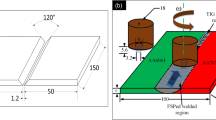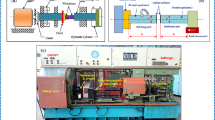Abstract
Friction stir processing (FSP) is a solid-state processing technique to enhance the surface properties of the metallic materials. The present study aims to improve the surface mechanical and wear properties of Cu–0.18wt.%Zr alloy through FSP without deteriorating its electrical conductivity behavior. The Cu–Zr alloy was friction stir processed at a constant tool rotation speed of 600 rpm and by varying the tool travel speed from 50 to 200 mm/min. The specimens were extracted from the stir zone to characterize its microstructure, mechanical properties and wear behavior. It was observed that the average size of grains in stir zone decreased from 40.5 to 4.6 µm with the increase in tool travel speed, whereas hardness of the processed specimens increased from initial 70 to 99 Hv. The coefficient of friction was decreased from 0.4 to 0.07 (µ) as travel speed increased. Consequently, the wear resistance of the processed samples increased with the travel speed. The change in electrical conductivity, as measured using eddy current technique, was noted to be insignificant in the processed specimens, i.e., it decreased to 77.4% IACS from its initial 78.2% IACS. Hence, the objective of improving the mechanical and wear resistance properties of Cu–Zr alloy was achieved without impairing the electrical conductivity by friction stir processing. The results suggest that friction stir processing can be effectively used to improve the wear behavior of high-strength and high-electrical conductivity alloys.





Similar content being viewed by others
References
Juarez-Islas J A, Perez R, Albarran L A, Rivera V, and Martinez L. J Mater Sci Lett 11 (1992) 1104.
Arnberg L, Backmark U, Backstrom N, and Lange L, J Mater Sci Eng 83 (1986) 115.
Wright R N, and Anderson I E, J Mater Sci Eng A 114 (1989) 167.
Tu J P, Qi W X, and Yang Y Z, Wear 249 (2002) 1021.
Holzwarth U, Stamm H, Pisoni M, Volcan A, and Scholz R, Fusion Eng Des 51 (2000) 111.
Palma R H, Sepulveda A, Espinoza R, Dianez M J, Criado J M, and Sayagues M J, J Mater Sci Eng A 391 (2005) 60.
Wongsa-Ngam J, Kawasaki M, and Langdon T, Mater Sci Eng A 556 (2012).
Wongsa-Ngam J, Kawasaki M, Zhao Y, and Langdon T G, Mater Sci Eng 528 (2011) 7715.
Mishra R S, Ma Z Y, Charit I, Mater Sci Eng A 341 (2003) 307.
Sarmadi H, Kokabi A H, and Seyed Reihani S M, Wear 304 (2013) 1.
Morisada Y, Fujii H, Nagaoka T, and Fukusumi M, Mater Sci Eng A 419 (2006) 344.
Shafiei-Zarghani A, Kashani-Bozorg S F, and Zarei-Hanzaki A, Mater Sci Eng A 500 (2009) 84.
Jafari J, Besharati Givi M K, and Barmouz M, Int J Adv Manuf Technol 78 (2015) 199.
Surekha K, and Els-Botes A, Mater Des 32 (2011) 911.
Ma Z Y, Mishra R S, and Mahoney M W, Acta Mater 50 (2002) 4419.
Barmouz M, Asadi P, Besharati Givi M K, and Taherishargh M, Mater Sci Eng A 528 (2011) 740.
Archard J F, J Appl Phys 24 (1953) 981.
Srinivasu R, Sambasiva Rao A, Madhusudhan Reddy G, and Srinivasa Rao K (2015) Def Technol 11 (2015) 140.
Takata N, Lee SH, and Tsuji N, Mater Lett 63 (2009) 1757.
Acknowledgements
The authors greatly acknowledge the support rendered by DRDO-DMRL, Hyderabad, in conducting FSP experiments at their facility.
Author information
Authors and Affiliations
Corresponding author
Additional information
Publisher's Note
Springer Nature remains neutral with regard to jurisdictional claims in published maps and institutional affiliations.
Rights and permissions
About this article
Cite this article
Bheekya Naik, R., Venkateswara Reddy, K., Madhusudhan Reddy, G. et al. Development of High-Strength and High-Electrical Conductivity Cu–Zr Alloy Through Friction Stir Processing. Trans Indian Inst Met 72, 1431–1435 (2019). https://doi.org/10.1007/s12666-019-01623-1
Received:
Accepted:
Published:
Issue Date:
DOI: https://doi.org/10.1007/s12666-019-01623-1




